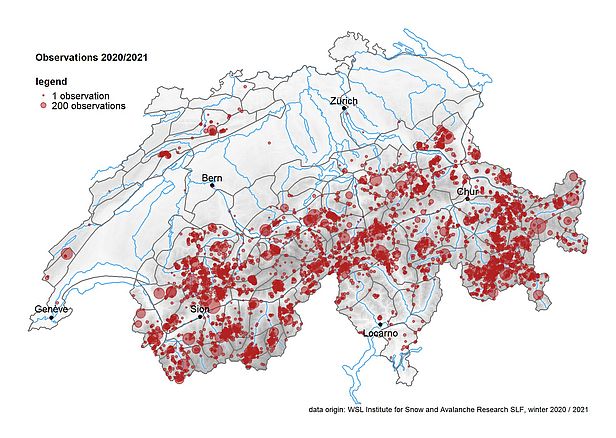The avalanche warning service has a wide range of data at its disposal, including measurements, observations, assessments and model results. Only the interplay between them ensures that the avalanche bulletin is as reliable as possible in all the different situations that can occur.
Measurements
With a view to producing the avalanche bulletin and also for climatological and hydrological purposes, the SLF operates an extensive network of measuring stations. This is set out in more detail on the pages for the current measured values.
Observations and assessments
Current field data are required to ensure that users can rely on the bulletins, which is why the SLF maintains its own network of observers. The official observers are trained by the SLF, report regularly on their findings and get paid for their reports. Different data may be collected depending on the situation, including for example estimates of fresh-fallen snow and fresh snowdrift, observed alarm signals and avalanches and often also an assessment of the current avalanche danger.
Additional information comes from local safety services, rescue organisations and the police and also of course from winter sports enthusiasts.

SLF observers
Some of the SLF observers generally file their reports from one and the same region, which is usually the place where they live or work. Some of these perform measurements at a measuring site as well as providing observations. If possible, these observers report their findings daily throughout the winter, thereby providing basic data coverage for the area in question. The reports are submitted between 6 and 8 am, or in the middle of the day.
Other SLF observers move freely within the territory of the Swiss Alps. They submit their reports whenever they have information of interest from their respective location.
Public reporting
The extent of the Swiss Alps and regional differences mean that the official observers can never cover everything. As a result, the avalanche warning service also relies on reports from private individuals. Therefore, we would like to encourage everyone to submit their own observations – thank you very much!
Time permitting, the avalanche forecasters also search other platforms such as www.bergportal.ch and www.camptocamp.org for avalanche information.
Avalanches
In addition to the avalanches reported by the observers, avalanche accidents are reported by the rescue services. Furthermore, avalanche maps of various skiing areas and the data from automatic avalanche detection systems are available to the members of the avalanche service.
Snow profiles and stability tests
Layering and snowpack stability have a major impact on the avalanche danger but are difficult to ascertain. To address this, at the start and middle of the month specially trained SLF observers spread across the Swiss Alps. Each produces around 40 flat-field profiles at set measuring sites and also some 40 slope profiles, using for example stability tests ('Rutschblock' tests) on representative test slopes. The most recent profiles are made available to the public at slf.ch, whiterisk.ch and on the White Risk app.
Weather forecasts (weather models and edited forecasts)
An avalanche danger forecast is also always based on a weather forecast. Among the products available to the avalanche forecasters to evaluate the short-term weather outlook are:
- MeteoSwiss's COSMO 1E and COSMO 2E meteorological forecasting models
- models of the SLF’s operational snow-hydrological service (OSHD)
- the European Centre for Medium-Range Weather Forecasts' ECMWF meteorological forecasting model
- various edited weather and precipitation forecasts from MeteoSwiss
- additional products from other suppliers if need be
The members of the avalanche warning service are also in regular contact with the forecasters from MeteoSwiss and SRF Meteo, meaning that difficult situations can also be discussed individually at any time.
Snowpack models
SNOWPACK, the snowpack model devised at the SLF, can be used to draw conclusions about the snowpack based on meteorological data. Alongside other applications, SNOWPACK is used to continuously model the snow layering at every IMIS snow station site throughout the winter. These outputs are used operationally by the avalanche forecasters, for instance to determine the depth of fresh-fallen snow or, when the snow is melting, to forecast wet-snow avalanches. In addition, SNOWPACK and other models form the basis of numerical forecast models constructed using machine learning techniques. Such models have been helping the avalanche forecaster to make their operational assessments since the winter of 2021/22.
Information in border areas
Avalanche danger transcends national borders. To facilitate a better assessment in border regions, information is regularly exchanged with the neighbouring countries' avalanche warning services. The avalanche forecasters also play an active role in the European Avalanche Warning Services (EAWS) association – also see www.avalanches.org.